Cross Bench Stretched Crunches
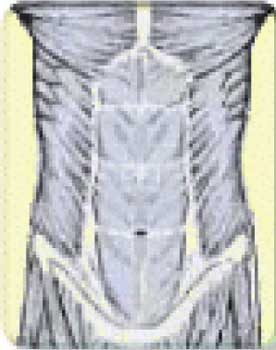
Why Is This Exercise So Effective?
This exercise is perfect for hitting the other half of the range of motion that floor crunches miss. This is the range where your spine is flexed backwards and your abdominals are in a stretched position.
Traditional crunches that are done with your back flat on the floor don’t allow for maximum spinal flexion, thereby limiting the useful range of motion of the exercise.
How To Do It
- A flat bench is used for this exercise.
- Your body will be perpendicular to the bench during the movement.
- Lie down across the bench with your lower back completely supported and your feet on the ground.Your upper body will be hanging over the edge from the mid-back up.
- Hold your arms so that your elbows are pointing forward over your face and your hands are near the top of your head.
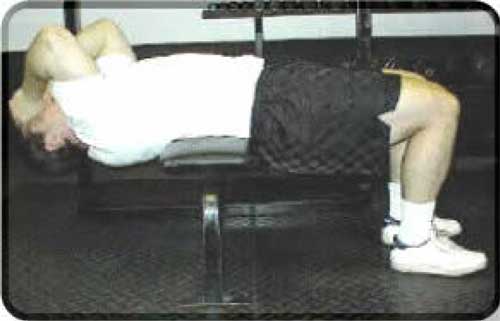
- Arch down backwards (don’t go too far - just get a good stretch) then crunch back up.
- You can hold weight in your hands once you get stronger but be careful with your back - make sure it is always supported.
- With any stretched crunch, don’t cradle your hands behind your head. Your neck flexibility will then limit how much stretch you can put on your abs. Hold your hands over your head at arm’s length for the best stretch.
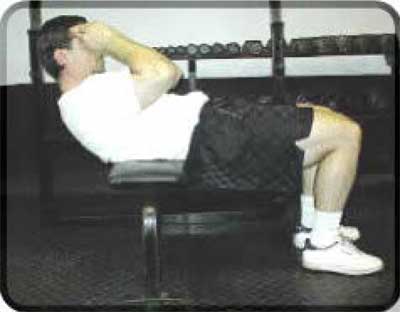
How to incorporate this exercise into your workouts:
This exercise targets the stretched range of motion of the abdominals.
- Do this exercise first in your abdominal training routine.
- Stretch position exercises are very effective when done first as they allow you to achieve a stronger contraction when you move on to contracted-position oriented exercises.
Common Errors
1. Stretching too far
Do not stretch so far back down or you will risk injury to your back. If you can see the floor directly behind you, you have gone too far.
Only do this exercise if your lower back is not injured or sensitive. The stretch position can be hard on the back if it is in a weakened state.
2. Going too fast
This exercise should be done slowly and deliberately. Done at a slow pace, it is quite safe for the back. Done quickly and using excessive momentum, it can be very dangerous to the back.
3. Improper position on the bench
The placement of your body on the bench is critical to the safety and effectiveness of this exercise. Your lower back from the area just above your waistband to your midback should be supported on the bench.
- Placing your upper back on the bench will limit your stretch and decrease the tension on your abs, but it will make the exercise easier on your lower back.
- Placing your glutes on the bench will send too much of your upper body over the edge of the bench, putting pressure on your lower back and throwing off your balance. This imbalance may cause you to tip over backwards.
Tricks
1. The Swiss Ball Crunch
If you have access to a Swiss Ball you can do stretched crunches on that instead of a bench.
- The execution is the same but it is much easier on your lower back and has the added bonus of making you stabilize yourself during the movement.
- Don’t anchor your feet when you do this exercise as that will decrease the valuable instability and activate the hip flexors.
- You can roll the ball back for a bigger stretch, forward to make it easier, or to the sides to work the obliques. Practice rolling around a little while crunching to get a feel for how ball movement affects abdominal involvement.
An excellent variation of the Swiss Ball Crunch is the small ball crunch. This is done using a much smaller, inflatable ball, e.g. around 16 to 24 inches in diameter. The smaller ball increases the instability of the exercise, forces your abs to support more of your bodyweight and increases the amount of stretch placed on the abs.
Most children’s toy stores or sporting goods stores have small, inflatable balls. Look for one that has thick rubber as you will be resting much of your bodyweight on it. Test it in the store before you bring it home.
2. How to add resistance
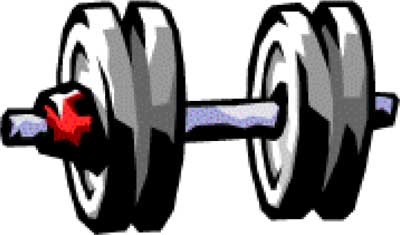
The simplest way to add resistance is to hold a weight plate or a dumbbell. Hold the weight either close behind your head with your arms bent (harder) or on your chest (easier).
Holding the weights this way will minimize shoulder and lower back stress. You may wish to have someone hand you the weight but you will normally not be using so much weight that you’ll need someone to hand it to you.
Using a low pulley cable can be even better for adding resistance because you will get tension as you are moving horizontally, not just vertically. Set your bench up so that your head is pointing to the low pulley then reach back and grasp it. Start very light when first using the cable.
There is more tension at the fully contracted position with cables. Because of this, continue the movement all the way up until your upper body is almost vertical.
- Use a bar, rope, two handles, or grip on the sides of a single handle.
- Get a good stretch and suck in your gut. At the stretch position, take a deep breath to expand your rib cage. Drop your hips down then crunch up and over the bench.
- At the top, only your lower back should be in contact with the bench and you will look like you’re nearly in a sitting position (though you’ll be squatting). Squeeze hard at the top then breathe in and out a few times while squeezing to really get a burn going.
A good way to spot yourself on this variation is a technique I call Body Ratcheting.
- When you get to the sticking point, raise your legs off the ground like a leg raise, lock your arms and abs, then allow the momentum of your legs dropping to carry the weight to the next point. You can continue this all the way through the movement. The only limit here is how much your abs can take.
- You can also change the force curve of this exercise by moving the bench further away or closer to the stack.
3. Self-spotting
- You can spot yourself by holding a weight plate or dumbbell.
- Hold the weight over head or in front of your chest during the stretch phase.
- Holding the weight will make it harder at the stretch but it will allow you to give yourself forced reps as you come to the contraction.
- Bring the weight overhead in a pullover movement and hold it in front of you as a counterbalance. This lets gravity help you crunch up.
- Move the weight back overhead when you go back down to the stretch position.
4. Feet up
A very advanced variation of this movement entails keeping your feet off the ground for the duration of the movement. This should only be attempted by advanced trainers with both strong abdominal and lower back muscles.
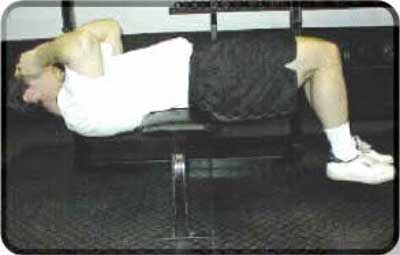
- Balance is the key issue in this variation and will require a lot of practice to get right.
- You should place yourself slightly higher on the bench because your legs are no longer balancing on the ground.
- This will vary according to your own personal weight distribution but a good rule of the thumb is that the front edge of the bench should be about 1 to 2 inches below your waistband.
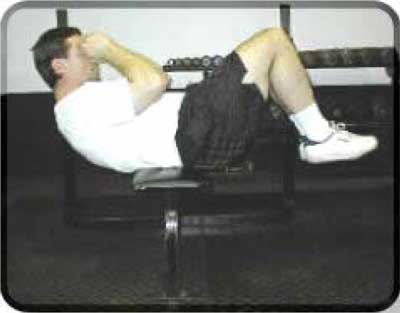
- As far as the movement goes, you should raise your legs up towards your chest slightly as you crunch your upper body up.
- This will counterbalance your changing weight distribution. If you don’t raise your legs, you will tip forward.
- Keep your abs tight throughout the exercise and don’t stretch back quite as far as with the feet-on-the-ground version. A little below horizontal is fine.
- Above all, take this one slowly and be careful!






